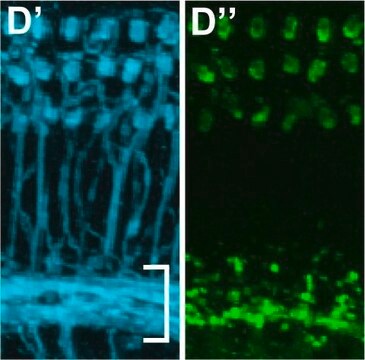AB5380
Anti-Nitric Oxide Synthase I Antibody
serum, Chemicon®
Synonym(s):
NOS I, bNOS, nNOS
Sign Into View Organizational & Contract Pricing
All Photos(1)
About This Item
UNSPSC Code:
12352203
eCl@ss:
32160702
NACRES:
NA.41
Recommended Products
biological source
rabbit
Quality Level
antibody form
serum
antibody product type
primary antibodies
clone
polyclonal
species reactivity
mouse, sheep, rat, human, monkey
manufacturer/tradename
Chemicon®
technique(s)
immunohistochemistry: suitable
western blot: suitable
NCBI accession no.
UniProt accession no.
shipped in
dry ice
target post-translational modification
unmodified
Gene Information
human ... NOS1(4842)
Specificity
Recognizes Neuronal nitric oxide synthase (nNOS, NOS-I, bNOS). No cross reaction with iNOS and eNOS by immunohistochemistry.
Immunogen
Recombinant human neuronal nitric oxide synthase.
Application
Research Category
Neuroscience
Neuroscience
Research Sub Category
Oxidative Stress
Oxidative Stress
This Anti-Nitric Oxide Synthase I Antibody is validated for use in IH, WB for the detection of Nitric Oxide Synthase I.
Western blot: 1:1,000-1:3,000 (ECL).
Immunohistochemistry: 1:1,000-1:2,000 (ABC).
Optimal working dilutions must be determined by end user.
Immunohistochemistry: 1:1,000-1:2,000 (ABC).
Optimal working dilutions must be determined by end user.
Target description
161 kDa
Linkage
Replaces: AB1552
Physical form
Rabbit Serum. Liquid containing 0.05% sodium azide.
Unpurified
Storage and Stability
Maintain for 6 months at -20°C from date of shipment. Aliquot to avoid repeated freezing and thawing. For maximum recovery of product, centrifuge the original vial after thawing and prior to removing the cap.
Analysis Note
Control
Brain tissue
Brain tissue
Other Notes
Concentration: Please refer to the Certificate of Analysis for the lot-specific concentration.
Legal Information
CHEMICON is a registered trademark of Merck KGaA, Darmstadt, Germany
Disclaimer
Unless otherwise stated in our catalog or other company documentation accompanying the product(s), our products are intended for research use only and are not to be used for any other purpose, which includes but is not limited to, unauthorized commercial uses, in vitro diagnostic uses, ex vivo or in vivo therapeutic uses or any type of consumption or application to humans or animals.
Not finding the right product?
Try our Product Selector Tool.
recommended
Product No.
Description
Pricing
Storage Class Code
10 - Combustible liquids
WGK
WGK 1
Certificates of Analysis (COA)
Search for Certificates of Analysis (COA) by entering the products Lot/Batch Number. Lot and Batch Numbers can be found on a product’s label following the words ‘Lot’ or ‘Batch’.
Already Own This Product?
Find documentation for the products that you have recently purchased in the Document Library.
Yong Hwan Kwon et al.
PloS one, 12(1), e0169113-e0169113 (2017-01-04)
The gastric accommodation reflex is an important mechanism in gastric physiology. However, the aging-associated structural and functional changes in gastric relaxation have not yet been established. Thus, we evaluated the molecular changes of interstitial cell of Cajal (ICC) and neuronal
Gaetano Scala et al.
Anatomical record (Hoboken, N.J. : 2007), 290(11), 1399-1412 (2007-10-12)
Choroid plexuses (CPs) play pivotal roles in many processes that establish, survey, and maintain the biochemical and cellular status of the central nervous system (CNS). Changes in the anatomy and physiology of CPs have been linked to several CNS diseases.
Sun Min Lee et al.
Journal of neurogastroenterology and motility, 23(4), 592-605 (2017-08-05)
Neuronal degeneration and changes in interstitial cells of Cajal (ICCs) are important mechanisms of age-related constipation. This study aims to compare the distribution of ICCs and neuronal nitric oxide synthase (nNOS) with regard to age-related changes between the ascending colon
Hui Dong et al.
American journal of physiology. Cell physiology, 308(5), C405-C413 (2014-12-30)
Mechanosensitivity of enteric neurons has been reported in the small intestine and colon, but not in the esophagus. Our earlier in vivo studies show that mechanical stretch of the esophagus in the axial direction induces neurally mediated relaxation of the
Chiara Traini et al.
Journal of cellular and molecular medicine, 23(6), 4076-4087 (2019-04-05)
Urothelium and Lamina Propria (LP) are considered an integrate sensory system which is able to control the detrusor activity. Complete supra-sacral spinal cord lesions cause Neurogenic Detrusor Overactivity (NDO) whose main symptoms are urgency and incontinence. NDO therapy at first
Our team of scientists has experience in all areas of research including Life Science, Material Science, Chemical Synthesis, Chromatography, Analytical and many others.
Contact Technical Service







